Well, one of the reasons is fairly obvious: most actual photographs we own are relatively old because they usually have been taken before the digital age and therefore hold value through their sheer existence. Apart from that, they may only exist in that one version (except if we still hold the negatives, of course. Yes: there was such a thing as a negative to create photographs from!). The fact that photographs are unique artefacts and cannot be reproduced easily makes us perceive them as important, valuable, rare,… and therefore worth our continued consideration. Also, paper photographs often hold specific memories, and depict those relatives or friends that we are no longer in touch with or – worse yet – have passed away since then. And that is another good reason to keep those photographs safe as they are part of our set of accumulated memories and memorabilia of better days. Those who remember what a world of hassle it was to take those photographs – setting up the camera, holding the pose, making sure everything is just right, then waiting for the film to be full, bring it to be developed and returned after maybe a week or two – know how thrilling it was to see those photographs for the first time. And how often those photos were badly lit, out of focus, with heads half cut off, etc. No wonder we keep the ones that came out right! However, I have seen situations where photographic evidence of a life lived to the fullest has taken over complete rooms, especially when those images were not actually on paper, but they were kept as photographic slides and visible only through projection on a wall. Many are the times that I have been held prisoner by someone insisting that I view all 600 slides of their beach vacation somewhere with a lot of cacti or scores of people in bathing suits. Yawn. And I have heard a lot more stories from other people telling me similar stories, both about photographic slides AND photo albums. Of course, those photographs are memories, but there is a rationale to keep only the ones that actually mean something and sift through the multiple images of the same thing occasionally and discard some of them. It also pays to make space for the newer by removing some of the less relevant photographs at some point. Clearly, a proper selection has to be made: separating the important ones from the disposable ones because we don’t want to be deprived of anything important or emotional, do we? This is tricky business, especially if we end up looking at all those images and spend a lot of time over it. It’s hard to compare images glued to photo albums across pages and make selections, let alone look at multiple albums holding similar materials. It’s a long process that could take a lifetime, since we may have spent a lifetime accumulating all those photographs. Being distracted by the images themselves is only the first obstacle: if you manage to identify the ones you are ready to let go (and you are not lucky enough to dispose of a complete album), the next question looms: what do you do with the photographs you do not keep? There might be historical relevance to some of them, so a specialist museum might be interested? Some could be interesting for family members. So, how DO you deal with photographs: for one thing, don’t expect to make a lot of headway, especially in the beginning. Each photograph has its own story, and the first step has to be getting a feel for the full collection. Why? This ‘inventory’ gives a first clue of repetitive items like pictures from the same beach over a period of several years, or repeat visits to a particular city. There might be a case to group those together and let go of the bad ones or proper doubles. From a practical point of view it could prove useful to take the photographs out of their albums, sort them all, make the cut, and then rearrange into albums again (if that is desirable). Where it comes to portraits of people, a similar approach works wonders on occasion: yes, we want to be reminded of the progression of a person through life, but a point could be made to limit the number of similar images to a balance between “enough to remember” and “too much to manage”. Once again, making separate piles for different people or groups could work wonders. Not only do we get to see each person on its own, but we also become acutely aware of bad photographs or series of the same ones. Some, however, are just that: irrelevant to you or anyone else, like those photographs of nameless landscapes we cannot remember, people we don’t know, or cityscapes we are no longer familiar with… maybe it’s time to let go of those. I have a practical way of doing this for myself: if I come across a photograph of someone I don’t recognise or where I get annoyed by the bad quality, bad framing, unfocused nature of a photo, I tend to make the cut there and then. I take it out and get rid of it, because if it annoys me now, usually I have had that reaction multiple times in the past and am likely to have the same reaction again in the future. It’s time to let go, I say. As for saving space and NOT returning photographs to their albums, we could try and scan photographs into digital formats. Photo albums tend to take a lot of space and some digitisation might be in order, if the person who has collected the photographs is okay with it and is actually able to make use of the digital versions afterwards. This is often rather a tricky issue if it involves an elderly relative: would your great-grandmother do with a digital picture, now? Another problem with digital is that the photograph loses its tactile nature and becomes a purely visual object. Just like books, photographs hold some of their content through touch, and that is an integral part of the experience and memory. The sensation of turning pages in the album, the click clack sound of the slide projector during the presentation of the memories, the smell of paper, all those are part of the memory. Not the original memory, naturally, but the accumulated weight of the memory as it has grown over the years. These external factors make a big part of the experience and should never be dismissed out of hand, they cannot be easily understood by someone else, but they are real to the person in question! Suffice it to say, photo albums tend to be a sticky subject. There’s no easy way to avoid letting go of things if you really want to downsize: either we lose a number of photographs and albums, or we digitise it all and lose part of the experience. The main concern should, however, be the memory itself that is conveyed by the photograph and I believe this is our way out of this conundrum: the photographs are just reminders of any memory that resides in us anyway. Think of them as messengers to remind us. As is the case with any kind of memorabilia, I would often argue that if a memory is not strong or important enough to stick to the brain on its own, maybe it’s not worth remembering and making space for new ones? That may sound harsh and a little like “survival of the fittest”, but to me it often feels like clinging on to something that has had its time and is ready to leave. I’ll leave you with the following thought: “If a memory is only kept alive through an object, maybe it’s had its day?” If you have enjoyed reading this, you may find these other articles interesting: Comments are closed.
|
Ask the ClutterMeisterIdeas to help clear away the mess in your homes and in your minds.
Feel free to share any of my posts, but please put in a backlink to the original blog post. Thank you. The author
Hi, my name is Tilo Flache. My mission: help clients declutter mind and space.
This blog contains pointers for your journey towards a happier living experience. Archives
November 2023
|




 RSS Feed
RSS Feed




